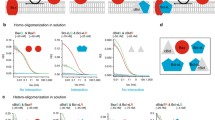Abstract
The proteins of Bcl-2 family are key regulators of apoptosis. Many Bcl-2 proteins have the unique ability to switch between two possible conformations, soluble in the cytosol or associated to cellular membranes. Importantly, their membrane-inserted form is the main responsible for their apoptotic function. Unfortunately, there are only a limited number of methods available to study the membrane activity of these proteins. Here, we present a methodology to study protein binding to membranes and membrane permeabilization at the single vesicle level. It is based on purified proteins and giant unilamellar vesicles and involves directly visualization of the process with a confocal microscope. This approach allows for the characterization of the membrane activity of the Bcl-2 proteins (or of any other pore-forming molecule) with unprecedented detail.
Access this chapter
Tax calculation will be finalised at checkout
Purchases are for personal use only
Similar content being viewed by others
References
Iacovache I, van der Goot FG, Pernot L (2008) Pore formation: an ancient yet complex form of attack. Biochim Biophys Acta 1778:1611–1623
Lindsay J, Esposti MD, Gilmore AP (2011) Bcl-2 proteins and mitochondria – specificity in membrane targeting for death. Biochim Biophys Acta 1813:532–539
Westphal D, Dewson G, Czabotar PE, Kluck RM (2011) Molecular biology of Bax and Bak activation and action. Biochim Biophys Acta 1813:521–531
Leber B, Geng F, Kale J, Andrews DW (2010) Drugs targeting Bcl-2 family members as an emerging strategy in cancer. Expert Rev Mol Med 12:e28
Garcia-Saez AJ (2012) The secrets of the Bcl-2 family. Cell Death Differ 19:1733–1740
Leber B, Lin J, Andrews DW (2010) Still embedded together binding to membranes regulates Bcl-2 protein interactions. Oncogene 29:5221–5230
Bleicken S, Wagner C, García-Sáez Ana J (2013) Mechanistic differences in the membrane activity of Bax and Bcl-xL correlate with their opposing roles in apoptosis. Biophys J 104:421–431
Landeta O, Landajuela A, Gil D, Taneva S, DiPrimo C et al (2011) Reconstitution of proapoptotic BAK function in liposomes reveals a dual role for mitochondrial lipids in the BAK-driven membrane permeabilization process. J Biol Chem 286:8213–8230
Lovell JF, Billen LP, Bindner S, Shamas-Din A, Fradin C et al (2008) Membrane binding by tBid initiates an ordered series of events culminating in membrane permeabilization by Bax. Cell 135:1074–1084
Czabotar Peter E, Westphal D, Dewson G, Ma S, Hockings C et al (2013) Bax crystal structures reveal how BH3 domains activate bax and nucleate its oligomerization to induce apoptosis. Cell 152:519–531
Suzuki M, Youle RJ, Tjandra N (2000) Structure of Bax: coregulation of dimer formation and intracellular localization. Cell 103:645–654
Montessuit S, Somasekharan SP, Terrones O, Lucken-Ardjomande S, Herzig S et al (2010) Membrane remodeling induced by the dynamin-related protein Drp1 stimulates Bax oligomerization. Cell 142:889–901
Sezgin E, Schwille P (2012) Model membrane platforms to study protein-membrane interactions. Mol Membr Biol 29:144–154
Walde P, Cosentino K, Engel H, Stano P (2010) Giant vesicles: preparations and applications. ChemBioChem 11:848–865
Fuertes G, Garcia-Saez AJ, Esteban-Martin S, Gimenez D, Sanchez-Munoz OL et al (2010) Pores formed by Bax alpha 5 relax to a smaller size and keep at equilibrium. Biophys J 99:2917–2925
Apellaniz B, Garcia-Saez AJ, Huarte N, Kunert R, Vorauer-Uhl K et al (2010) Confocal microscopy of giant vesicles supports the absence of HIV-1 neutralizing 2F5 antibody reactivity to plasma membrane phospholipids. FEBS Lett 584:1591–1596
Schon P, Garcia-Saez AJ, Malovrh P, Bacia K, Anderluh G et al (2008) Equinatoxin II permeabilizing activity depends on the presence of sphingomyelin and lipid phase coexistence. Biophys J 95:691–698
Steringer JP, Bleicken S, Andreas H, Zacherl S, Laussmann M et al (2012) Phosphatidylinositol 4,5-bisphosphate (PI(4,5)P2)-dependent oligomerization of fibroblast growth factor 2 (FGF2) triggers the formation of a lipidic membrane pore implicated in unconventional secretion. J Biol Chem 287:27659–27669
Bergstrom CL, Beales PA, Lv Y, Vanderlick TK, Groves JT (2013) Cytochrome c causes pore formation in cardiolipin-containing membranes. Proc Natl Acad Sci 110(16):6269–6274
Bleicken S, Garcia-Saez AJ, Conte E, Bordignon E (2012) Dynamic interaction of cBid with detergents, liposomes and mitochondria. PLoS One 7:e35910
Bleicken S, Classen M, Padmavathi PV, Ishikawa T, Zeth K et al (2010) Molecular details of Bax activation, oligomerization, and membrane insertion. J Biol Chem 285:6636–6647
Hermann et al (2014) Bioinformatics. doi: 10.1093/bioinformatics/btu102
Dimitrov DS, Angelova MI (1986) Swelling and electroswelling of lipids theory and experiment. Stud Biophys 113:15–20
Dimitrov DS, Angelova MI (1988) Lipid swelling and liposome formation mediated by electric-fields. Bioelectrochem Bioenerg 19:323–336
Author information
Authors and Affiliations
Corresponding author
Editor information
Editors and Affiliations
Rights and permissions
Copyright information
© 2014 Springer Science+Business Media New York
About this protocol
Cite this protocol
Bleicken, S., García-Sáez, A.J. (2014). New Biophysical Methods to Study the Membrane Activity of Bcl-2 Proteins. In: Wajapeyee, N. (eds) Cancer Genomics and Proteomics. Methods in Molecular Biology, vol 1176. Humana Press, New York, NY. https://doi.org/10.1007/978-1-4939-0992-6_16
Download citation
DOI: https://doi.org/10.1007/978-1-4939-0992-6_16
Published:
Publisher Name: Humana Press, New York, NY
Print ISBN: 978-1-4939-0991-9
Online ISBN: 978-1-4939-0992-6
eBook Packages: Springer Protocols



